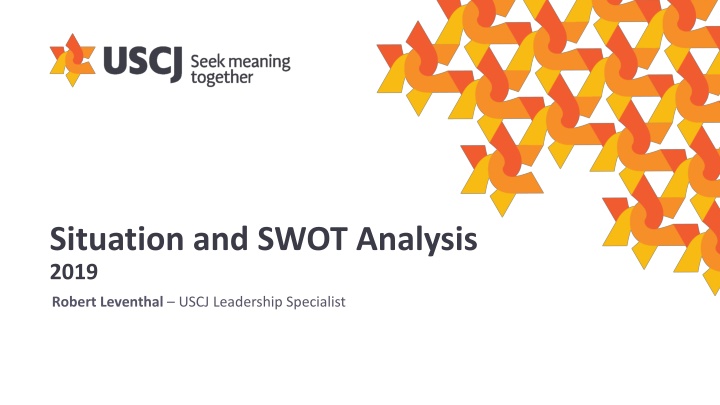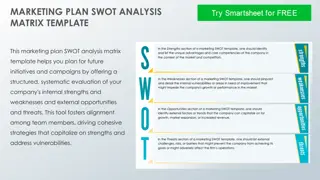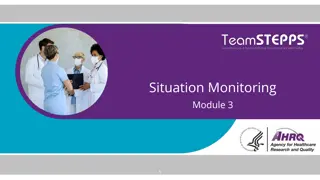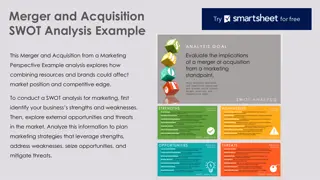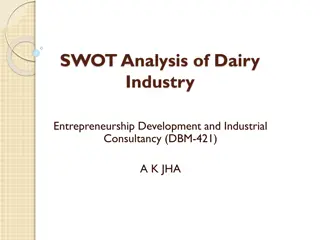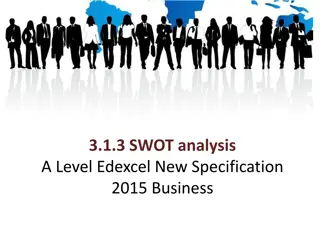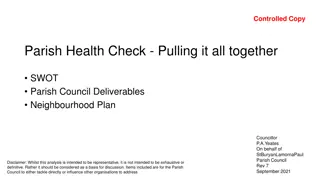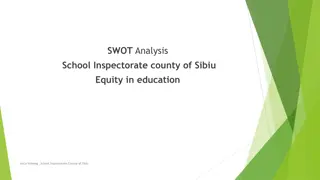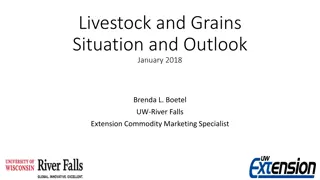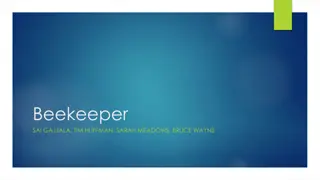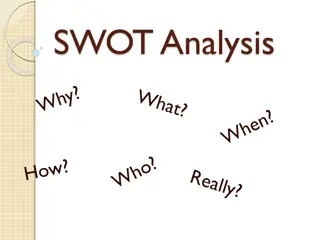Situation and SWOT Analysis
Conducting a SWOT analysis is essential for congregational leaders like Robert Leventhal to assess the current situation, identify strengths and weaknesses, capitalize on opportunities, and mitigate threats. Leveraging this analysis helps in making informed decisions, enhancing strategic planning, and fostering growth within the congregation.
Download Presentation

Please find below an Image/Link to download the presentation.
The content on the website is provided AS IS for your information and personal use only. It may not be sold, licensed, or shared on other websites without obtaining consent from the author.If you encounter any issues during the download, it is possible that the publisher has removed the file from their server.
You are allowed to download the files provided on this website for personal or commercial use, subject to the condition that they are used lawfully. All files are the property of their respective owners.
The content on the website is provided AS IS for your information and personal use only. It may not be sold, licensed, or shared on other websites without obtaining consent from the author.
E N D
Presentation Transcript
Situation and SWOT Analysis 2019 Robert Leventhal USCJ Leadership Specialist
Why do a SWOT? To get the lay of the land An Honest Assessment of the Current Situation Identify what is working well, so that you can do more of it Strengthen underdeveloped areas Identify weaknesses and limit things that are hurting the kehilla (congregation) Develop Foresight - Anticipate the Future Scan the environment to see future trends, factors and forces that will impact your kehilla Develop plans to take advantage of helpful opportunities Minimize harmful external forces (threats) 2
Describing the Current Situation Initial SWOT Exercise Strengths Weaknesses Internal- forces, trends and factors inside the synagogue that impact our future. What do we do well? Where can we improve? Opportunities Threats External- forces, trends and factors outside of the synagogue that impact our future. What changes are taking place in our environment that might allow us to better achieve our mission? What changes in the environment do we need to be aware of or prepare for in doing our work?
Text 1: Numbers 14 Should I Stay or Should I Go? 1The whole community broke into loud cries, and the people wept that night. 2All the Israelites railed against Moses and Aaron. If only we had died in the land of Egypt, the whole community shouted at them, or if only we might die in this wilderness! 3Why is the LORD taking us to that land to fall by the sword? Our wives and children will be carried off! It would be better for us to go back to Egypt! 4And they said to one another, Let us head back for Egypt.
Pre-Work for SWOT: Data Gathering Fact Book Exercise Thriving Congregations Assessment
Pre Work: Building a Fact Book: What do we need to know? What can we get? Internal Scan Attendance Membership by age, years as members Enrollment in schools Attendance at programs and services Satisfaction Parlor meetings- surveys Fundraising by event You may take this info from a placement application External Scan Demographics trends Competition Economics of area Lifestyle of community Competitive substitutes Schools Studies, articles, interviews about outside community, Jewish trends, other kehillot Contact your KRM for the SSP Fact Book 6
Pre Work: Thriving Congregation Assessment Have Planning Committee/ Team and Board Complete Debrief Process Have all participants do the following: Mark significant areas of strength with check mark Mark significant areas of concern with a question mark- these deserve further study in SSP
Pro Tip #1: Be Specific Rather than Strong School Try the following Award winning school, recognized for use of technology. Hebrew tutoring available with Israeli tutors on Skype. Teachers went for extensive training last year. Got Solomon Schecter award for cooperative learning program for 6thgrade.
Pro Tip #2: Be Honest & Hopeful Honest Assessment- the soil fertile? Is Hopeful Forward Looking- Spies must bring back fruit
Pro-Tip #3: Prune List of Strengths & Weaknesses and Prioritize Them Small Weakness- social hall needs new carpet Big Weakness- lack diversity of services to meet members needs Big Strength- 60% of religious school students stay through high school Small Strength- great book club
Pro Tip #4: Consider Doing Multiple SWOT Analyses Initial SWOT done by planning committee as Team Building Reflection. Edited version is SWOT 2.0. SWOT 3.0- Includes feedback from the Board, connects them to process. Edited version SWOT 4.0 helps task forces decide what to work on. Have task forces do a SWOT Source: Based on The Wheel of Learning The Fifth Discipline (Senge) for their focus area
Opportunities: Promotion Remind stakeholders that synagogues matter While overall the number of Conservative and Reform households continues to decline, for Conservative and Reform Jews, affiliation makes a huge difference in the level of engagement. Nearly three quarters (73%) of Conservative Jews who are members of a congregation have high or very high levels of Jewish engagement, compared with less than 15% of Conservative Jews not affiliated with a congregation. UJA Executive Summary p.27 Dix Hills Jewish Center
Opportunities: Partnerships Welcome to the Jewish Journey Project (JJP) JJP provides participants from 3rd to 7th grades with rich opportunities to engage in extensive educational opportunities outside of the classroom, making use of the vast Jewish resources of our great city of New York. Other partners, agencies, local universities
SWOT Exercise 60 Minutes Trigger Text: The Spies 10 minutes Review Fact Book 15 minutes Conduct the SWOT 30 minutes 10 minutes Strengths to Possibilities
Conduct SWOT Exercise Strengths (Left) Weaknesses (Right) Whole Group- 30 minutes Great facility- Renovated 5 years ago. Prime location near the JCC and major Jewish neighborhoods. Housing costs are rising. Some families are having to move 20 minutes away. With traffic it can be 30 minutes. The planners will take two (2) pages and make entries into each section. Use as many sheets as needed. Have to compete with children s sports on Sundays. Those who live farther out have poor attendance. Award winning religious school. Has new computer lab. Received awards for cooperative learning. Strength (Left) Weakness (right) Finish Strengths and Weaknesses before you do Opportunities and Threats.
Connect Strengths to Possibilities Strengths Great facility- Renovated 5 years ago. Prime location near the JCC and major Jewish neighborhoods. Possibilities Invite some independent minyanim to use great facility. Increase business for caterer. Social hall fees. Connect Strengths to Possibilities Create more opportunties for on line learning and small team projects that can be done off site. Award winning religious school. Has new computer lab. Received awards for cooperative learning.
Next Steps Ask KRM for Fact Book and Link to TCA Conduct TCA with SC and Board Debrief Data with Board Plan SWOT Exercise with Board
